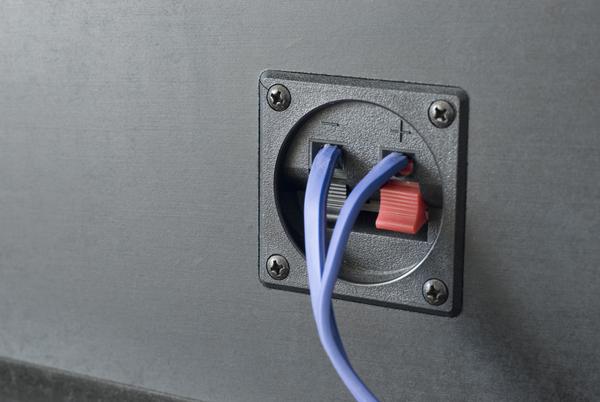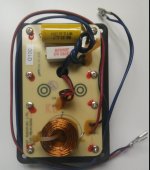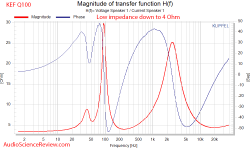Thank you for all the comments, although I don't understand everything 😉
I'm not an electronics/audio guy, so I have no clue. I know what a crossover is and how to solder together basic parts.
However, I would prefer to get one of these assembled crossovers, should they exist.
If I know the exact parts I can maybe also try to do it myself, but I doubt the quality is good enough.
I cannot turn on the (main) speaker, the second one depends on the main one I think. We've checked the parts for obvious problems at our Makerlab, but there is at least no visible problem.
I found a couple of threads mentioning that this seems to be a common issue, also a video KEF X300A issue with teardown and diagnosis (part 1) - YouTube with no part 2 🙁
There is no warranty, and based on what I read it is probably an issue with the power board.
I don't know any shops that would repair speakers like this (I'm in Austria) and it would probably not worth the effort.
Since replacing individual parts is beyond my ability, I thought I'd ask the experts here to see if I can convert them to passive speakers without a lot of effort and costs.
I'm not sure if it's worth it and how it affects quality. If there are crossovers I could order and try, I would start with that, probably.
I'm not an electronics/audio guy, so I have no clue. I know what a crossover is and how to solder together basic parts.
However, I would prefer to get one of these assembled crossovers, should they exist.
If I know the exact parts I can maybe also try to do it myself, but I doubt the quality is good enough.
I cannot turn on the (main) speaker, the second one depends on the main one I think. We've checked the parts for obvious problems at our Makerlab, but there is at least no visible problem.
I found a couple of threads mentioning that this seems to be a common issue, also a video KEF X300A issue with teardown and diagnosis (part 1) - YouTube with no part 2 🙁
There is no warranty, and based on what I read it is probably an issue with the power board.
I don't know any shops that would repair speakers like this (I'm in Austria) and it would probably not worth the effort.
Since replacing individual parts is beyond my ability, I thought I'd ask the experts here to see if I can convert them to passive speakers without a lot of effort and costs.
I'm not sure if it's worth it and how it affects quality. If there are crossovers I could order and try, I would start with that, probably.
That's what I would do and JM Fahey has given links to the type of ready made crossover you require.If there are crossovers I could order and try, I would start with that, probably.
If you are in Austria, you should have access to Sound Imports.
Order the Dayton Audio XO2W-4.5K - SoundImports
I've chosen the one with a high crossover frequency to allow for the KEF tweeter likely being nearer to 4 ohm than 8 ohm.
JMF may keep us right on that.
Order the Dayton Audio XO2W-4.5K - SoundImports
I've chosen the one with a high crossover frequency to allow for the KEF tweeter likely being nearer to 4 ohm than 8 ohm.
JMF may keep us right on that.
If you have a competent person in your lab, possibly put a new power supply?
But check the drivers have not blown before anything else.
But check the drivers have not blown before anything else.
How do I check the drivers?
The power supply is connected to the main board unfortunately, and not everything is directly visible on the board.
The power supply is connected to the main board unfortunately, and not everything is directly visible on the board.
Thanks for the confidence 🙂
The supplier found by Galu in post #23 looks fine, specially because it´s "local" (sort of) and seems to bypass Customs problems and allow for (hopefully) cheaper freight.
If second cabinet is also nuked or somehow can´t be turned ON, you should convert both ... which anyway would be recommended so both sound the same so you will need to order 2 crossovers ..... which will probably travel together so paying postage just once.
You can mount it yourself; the basic path would be:
1) remove metallic backplate which includes power amp, heatsink fins, etc.
If one of two still works, I would offer it on EBay for a reasonable price, at least covering conversion to passive expenses (wink wink 😉 )
Sooner or later somebody with your exact same problem will buy it.
2) I see power supply is separate,also remove it, leave only speakers inside ... like on any passive cabinet.
3) take and post pictures showing speakers back, to show terminals.
4) have a piece of plywood cut (or MDF) to become the new speaker back.
Suggest around 15 mm, you will use 3 screws per short side, 4 per long side, to avoid rattling or vibration. Paint it black or brown if you wish. Water based "latex" paint is fine.
5) drill back panel as needed for the cabinet connectors you will use.
Simplest is spring loaded push terminals,

you can also use some kind of screw/banana type:

6) mount your crossover board to the back panel or to the bottom of cabinet.
7) wire it, it has 6 self explanatory solder terminals:
* IN which goes to input terminals
* W(oofer)
* T(weeter)
+/- polarity is shown, use red wire for + , black for -
Really no way to do it wrong, very straightforwrd.
NOTE: you can "TRY before you buy"
Just to test functionality, get a couple 4.7uF x 50V electrolytic bipolar capacitors,

use one as a basic crossover :
* connect woofer straight to input terminals
*connect tweeter also to same terminals, but cut open the red wire and insert capacitor in series with it.
Close back and test cabinet.
Do you like what you hear?
If so, proceed with the full conversion, it will sound even better, and in fact much like the original active speaker.
NOTE: some will disagree with the 4.7uF cap choice, Math says it will crossover at 4000 something Hertz, suggest 10uF as a better choice.
Mathematically true, but fact is a single series capacitor is a very "slow" crossover, 6dB/oct lets way too much mids into Tweeter, a small dome does NOT like that, at all.
A common rule of thumb is use a half sized capacitor, which in practice works quite well.
The correct solution is of course to use the proper 12dB/oct crossover as suggested.
You might even find another brand locally, same specs, search around.
As I mentioned before, here many small PA operators make ends meet by converting dead active PA cabinets to passive and turn "junk" into breadwinners.
In all cases replacement boards are too expensive or straight unavailable.
FWIW I guess the YT video has no "part 2" simple because he did NOT repair those KEF; he suspected bulged caps (right) and ordered some, but something else must have been damaged.
The supplier found by Galu in post #23 looks fine, specially because it´s "local" (sort of) and seems to bypass Customs problems and allow for (hopefully) cheaper freight.
If second cabinet is also nuked or somehow can´t be turned ON, you should convert both ... which anyway would be recommended so both sound the same so you will need to order 2 crossovers ..... which will probably travel together so paying postage just once.
You can mount it yourself; the basic path would be:
1) remove metallic backplate which includes power amp, heatsink fins, etc.
If one of two still works, I would offer it on EBay for a reasonable price, at least covering conversion to passive expenses (wink wink 😉 )
Sooner or later somebody with your exact same problem will buy it.
2) I see power supply is separate,also remove it, leave only speakers inside ... like on any passive cabinet.
3) take and post pictures showing speakers back, to show terminals.
4) have a piece of plywood cut (or MDF) to become the new speaker back.
Suggest around 15 mm, you will use 3 screws per short side, 4 per long side, to avoid rattling or vibration. Paint it black or brown if you wish. Water based "latex" paint is fine.
5) drill back panel as needed for the cabinet connectors you will use.
Simplest is spring loaded push terminals,

you can also use some kind of screw/banana type:

6) mount your crossover board to the back panel or to the bottom of cabinet.
7) wire it, it has 6 self explanatory solder terminals:
* IN which goes to input terminals
* W(oofer)
* T(weeter)
+/- polarity is shown, use red wire for + , black for -
Really no way to do it wrong, very straightforwrd.
NOTE: you can "TRY before you buy"
Just to test functionality, get a couple 4.7uF x 50V electrolytic bipolar capacitors,

use one as a basic crossover :
* connect woofer straight to input terminals
*connect tweeter also to same terminals, but cut open the red wire and insert capacitor in series with it.
Close back and test cabinet.
Do you like what you hear?
If so, proceed with the full conversion, it will sound even better, and in fact much like the original active speaker.
NOTE: some will disagree with the 4.7uF cap choice, Math says it will crossover at 4000 something Hertz, suggest 10uF as a better choice.
Mathematically true, but fact is a single series capacitor is a very "slow" crossover, 6dB/oct lets way too much mids into Tweeter, a small dome does NOT like that, at all.
A common rule of thumb is use a half sized capacitor, which in practice works quite well.
The correct solution is of course to use the proper 12dB/oct crossover as suggested.
You might even find another brand locally, same specs, search around.
As I mentioned before, here many small PA operators make ends meet by converting dead active PA cabinets to passive and turn "junk" into breadwinners.
In all cases replacement boards are too expensive or straight unavailable.
FWIW I guess the YT video has no "part 2" simple because he did NOT repair those KEF; he suspected bulged caps (right) and ordered some, but something else must have been damaged.
That's awesome! Thank you very much for this detailed explanation!
I will order those crossovers and just give it a try.
Thank you very much, I will report back once I'm working on it
I will order those crossovers and just give it a try.
Thank you very much, I will report back once I'm working on it
Contrary to what seems to be recommended here, do yourself a favor and do not use non-specific/generic crossovers. You have one of the better coaxial woofer-tweeter combos available, which are capable of world class reproduction. Do not waste those capabilities with a non-dedicated x/o that basically screws up performance. Maybe you could ask someone to help you with assembling the right x/o.
Well if anyone wants to volunteer 😉
In the meantime: Can anyone maybe recommend a dac/amp for my desktop? Never used passive speakers on my computer. The only thing I've left lying around is a IQAudio Pi DigiAmp+
In the meantime: Can anyone maybe recommend a dac/amp for my desktop? Never used passive speakers on my computer. The only thing I've left lying around is a IQAudio Pi DigiAmp+
Buy an old amp at a flea market, rig it to computer sound output.
TPA3116 kits are also easy to make.
TPA3116 kits are also easy to make.
Hold off buying a Dayton crossover for the moment - I want to revise my suggestion of which one to buy.
Before choosing which Dayton crossover is best suited to your needs, we really need to be sure what the impedance of the tweeter is.
Why? Because if you use a 4 ohm tweeter with an 8 ohm crossover, the crossover frequency point will double, and is likely to leave a hole in the middle of the reproduction.
It is said that the Uni-Q drivers in the KEF LS50 are 4 ohm, but we need to be sure about yours.
If you disconnect the Uni-Q mid/bass and tweeter from the electronics, you can then measure the dc resistance of each driver with a multimeter and report back here with your measurements. Then we can choose the most appropriate Dayton crossover fron SoundImports.
Meanwhile, the original suggestion of simply wiring a non-polar capacitor in series with the tweeter in order to get the speakers up and running, as previously explained, is the way to progress.
Before choosing which Dayton crossover is best suited to your needs, we really need to be sure what the impedance of the tweeter is.
Why? Because if you use a 4 ohm tweeter with an 8 ohm crossover, the crossover frequency point will double, and is likely to leave a hole in the middle of the reproduction.
It is said that the Uni-Q drivers in the KEF LS50 are 4 ohm, but we need to be sure about yours.
If you disconnect the Uni-Q mid/bass and tweeter from the electronics, you can then measure the dc resistance of each driver with a multimeter and report back here with your measurements. Then we can choose the most appropriate Dayton crossover fron SoundImports.
Meanwhile, the original suggestion of simply wiring a non-polar capacitor in series with the tweeter in order to get the speakers up and running, as previously explained, is the way to progress.
To be clear about the Dayton two-way loudspeaker crossovers:
Shopping for assembled passive crossovers? - SoundImports
There are five two-way crossovers and we can choose between the following tweeter crossover frequencies: 2000, 2500, 3000, 3500 and 4500 Hz.A unique design feature of the low-pass section allows use of 4 or 8 ohm woofers, perfect for building D'Appolito style or multi woofer 2-way systems.
The high pass crossover frequency is rated for an 8 ohm load.
Shopping for assembled passive crossovers? - SoundImports
The best value desktop DAC around at the moment is the iFi Audio "Zen DAC V2".Can anyone maybe recommend a dac/amp for my desktop?
It also includes a headphone amp.
iFi Zen DAC V2 review | What Hi-Fi?
Simply use it with the amplifier of your choice.
Hold off buying a Dayton crossover for the moment - I want to revise my suggestion of which one to buy.
Before choosing which Dayton crossover is best suited to your needs, we really need to be sure what the impedance of the tweeter is.
Thanks! I will do this today or tomorrow.
There is a 4pin connector, so I assume I just identify the drivers and measure the resistance for both pairs.
Will also try to get the capacitor mentioned and do the test.
Last edited:
Agree with measuring each speaker DC resistance first to confirm impedance.
What is the passive KEF speaker which is the twin brother of the X300A?
I bet both use exact same speaker components, only one is active, the other passive, that should give us a clue.
I did see the 4 ohm/8 ohm "switch" in the Dayton crossover, thought (lacking any contrary statement) that it adapted the whole crossover to 4/8 ohm.
Oh well, let´s see those DCR measurements.
Remember to short meter probes first, read the "parasitic" resistance remaining, and substract that from what you read at speaker terminals.
What is the passive KEF speaker which is the twin brother of the X300A?
I bet both use exact same speaker components, only one is active, the other passive, that should give us a clue.
I did see the 4 ohm/8 ohm "switch" in the Dayton crossover, thought (lacking any contrary statement) that it adapted the whole crossover to 4/8 ohm.
Oh well, let´s see those DCR measurements.
Remember to short meter probes first, read the "parasitic" resistance remaining, and substract that from what you read at speaker terminals.
I've checked, and the active X300A employs the same Uni-Q driver as the passive Q100.What is the passive KEF speaker which is the twin brother of the X300A?
The specs of the Q100 state a nominal impedance of 8 ohm, but that does not necessarily mean the tweeter is 8 ohm.
A DC resistance measurement of the tweeter will keep us right!
If you can find a pair of these at a reasonable price then you have struck gold! 😎This is a Q100 crossover, if that helps: KEF Q100 Speaker Crossover - SP3722 | eBay
Actually, the Q100 crossover is surprisingly simple - one coil, one capacitor and one resistor!
It would be much cheaper to duplicate it by buying the individual components.
Would you be prepared to undertake building your own version of the crossover with some help from us?
It would be much cheaper to duplicate it by buying the individual components.
Would you be prepared to undertake building your own version of the crossover with some help from us?
Attachments
- Home
- General Interest
- Everything Else
- Dead KEF X300A - what to do with them?


